Terminal Distributed Cooperative Guidance Law for Multiple UAVs Based on Consistency Theory
Abstract
:1. Introduction
- (1)
- A new time-to-go estimation method is proposed, which is more accurate than the existing method in [32] when the leading angle is large.
- (2)
- A non-singular sliding mode guidance law (NSMG) of impact time control with equivalent control term and switching control term is designed, which still appears to have excellent performance even if the initial leading angle is zero, while some existing impact time control laws in [4,8,33] are invalid. Then the guidance law is extended to attack maneuvering targets.
- (3)
- Adopting hierarchical cooperative guidance architecture, a terminal distributed cooperative guidance law based on consistency theory is designed, which is not only applicable to different forms of communication topology, but also effective in the case of communication topology switching.
2. Problem Statement
3. Design of Bottom Guidance Law Based on Sliding Mode Control Theory
3.1. Time-to-Go Estimation of PNG Law
3.2. Design of the Impact Time Control Guidance Law
3.2.1. Design of the Guidance Law for Stationary Target
3.2.2. Proof of Stability
3.2.3. The Extension of the Guidance Law under the Maneuvering Target
4. The Upper-Level Distributed Coordination Strategy Based on Consistency
5. Numerical Simulation
5.1. Comparison of Methods for Time-to-Go Estimation
5.2. Verification of the Bottom Non-Singular Sliding Mode Guidance Law
5.2.1. Comparison of Non-Singular Sliding Mode Guidance Law (NSMG) Law and Sliding Mode Control (SMC) Law
5.2.2. Performance of the NSMG Law with Different Impact Time
5.2.3. Performance of the NSMG Law with Different Initial Leading Angles
5.2.4. Salvo Attack on Maneuvering Target with the NSMG Law
5.3. Verification of Upper Level Distributed Coordination Strategy
5.3.1. Ring Network Topology
5.3.2. Chain Network Topology
5.3.3. The Situation of Network Topology Switching
6. Conclusions
- (1)
- The time-to-go estimation method proposed in this paper is more accurate than [27] under large leading angles.
- (2)
- The non-singular sliding mode guidance law with impact time constraint at the bottom layer can be applied to strike missions under different initial conditions and designated impact time. For maneuvering targets, the predictive collision point strategy is used to extend the form of the guidance law, which can still achieve precise strike.
- (3)
- In this paper, the upper-layer distributed coordination strategy and the lower-layer non-singular sliding mode guidance law are combined to make the formation members exchange information with each other, so as to realize the time cooperative online closed-loop guidance under the condition of fixed or switching network topology of the UAV formation.
Author Contributions
Funding
Institutional Review Board Statement
Informed Consent Statement
Data Availability Statement
Conflicts of Interest
Nomenclature
| Acronyms | |
| UAV | Unmanned Aerial Vehicle |
| NSMG | nonsingular sliding mode guidance |
| PNG | Proportional Navigation Guidance |
| NTSMC | nonsingular terminal sliding mode control theory |
| LOS | line of sight |
| SMC | Sliding mode control |
References
- Lyu, T.; Guo, Y.; Li, C.; Ma, G.; Zhang, H. Multiple missiles cooperative guidance with simultaneous attack requirement under directed topologies. Aerosp. Sci. Technol. 2019, 89, 100–110. [Google Scholar] [CrossRef]
- Jiang, H.; An, Z.; Yu, Y.; Chen, S.; Xiong, F. Cooperative guidance with multiple constraints using convex optimization. Aerosp. Sci. Technol. 2018, 79, 426–440. [Google Scholar] [CrossRef]
- Chen, Y.; Xiang, S.; Jiang, D.; Li, J.; Chen, S. Research on Modified Proportional Guidance Method with Attack Time Control. Acta Sichuan Armory Eng. 2018, 39, 88–92. [Google Scholar]
- Kumar, S.R.; Ghose, D. Impact time guidance for large heading errors using sliding mode control. Aerosp. Electron. Syst. IEEE Trans. 2015, 51, 3123–3138. [Google Scholar] [CrossRef]
- Liu, Y.; He, G.; Qiao, Z.; Guo, Z.; Wang, Z. Measurement Compensation for Time-Delay Seeker and Three-Dimensional Adaptive Guidance Law Design. Sensors 2021, 21, 3977. [Google Scholar] [CrossRef] [PubMed]
- Che, F.; Niu, Y.; Li, J.; Wu, L. Cooperative Standoff Tracking of Moving Targets Using Modified Lyapunov Vector Field Guidance. Appl. Sci. 2020, 10, 3709. [Google Scholar] [CrossRef]
- Jeon, I.S.; Lee, J.I.; Tank, M.J. Impact-Time-Control Guidance Law for Anti-Ship Missiles. IEEE Trans. Control. Syst. Technol. 2006, 14, 260–266. [Google Scholar] [CrossRef]
- Zhang, S.; Zang, X.; Liang, S. Research on the Terminal Guidance Law for TV-Guided UCAV Ground Attacking with high Impact angle. Aircr. Des. 2016, 36, 34–37. [Google Scholar]
- Wang, Y. Sliding-Mode Guidance Law on UAV with LOS Controllable. Mod. Navig. 2018, 9, 65–69. [Google Scholar]
- Cui, N.; Wang, B.; Ji, Y. A Cooperative Guidance Law Based on Second Order Sliding Mode Control Theory. Aerosp. Control. 2018, 36, 40–46. [Google Scholar]
- Liu, X.; Han, Y.; Li, P.; Guo, H.; Wu, W. Target Tracking Enhancement by Three-Dimensional Cooperative Guidance Law Imposing Relative Interception Geometry. Aerospace 2021, 8, 6. [Google Scholar] [CrossRef]
- Kim, M.; Hong, D.; Park, S. Deep Neural Network-Based Guidance Law Using Supervised Learning. Appl. Sci. 2020, 10, 7865. [Google Scholar] [CrossRef]
- Hong, D.; Kim, M.; Park, S. Study on Reinforcement Learning-Based Missile Guidance Law. Appl. Sci. 2020, 10, 6567. [Google Scholar] [CrossRef]
- Nikusokhan, M.; Nobahari, H. Closed-form optimal cooperative guidance law against random step maneuver. IEEE Trans. Aerosp. Electron. Syst. 2016, 52, 319–336. [Google Scholar] [CrossRef]
- Zhao, J.; Zhou, R.; Dong, Z. Three-dimensional cooperative guidance laws against stationary and maneuvering targets. Chin. J. Aeronaut. 2015, 28, 1104–1120. [Google Scholar] [CrossRef] [Green Version]
- Zhao, J.; Zhou, R. Unified approach to cooperative guidance laws against stationary and maneuvering targets. Nonlinear Dyn. 2015, 81, 1635–1647. [Google Scholar] [CrossRef]
- Zhao, Q.; Dong, X.; Song, X.; Ren, Z. Cooperative time-varying formation guidance for leader-following missiles to intercept a maneuvering target with switching topologies. Nonlinear Dyn. 2018, 95, 129–141. [Google Scholar] [CrossRef]
- Zhou, J.; Lyu, Y.; Li, Z.; Yang, J. Cooperative Guidance Law Design for Simultaneous Attack with Multiple Missiles Against a Maneuvering Target. J. Syst. Sci. Complex. 2018, 31, 287–301. [Google Scholar] [CrossRef]
- Shaferman, V.; Shima, T. Cooperative Optimal Guidance Laws for Imposing a Relative Intercept Angle. J. Guid. Control. Dyn. 2015, 38, 1395–1408. [Google Scholar] [CrossRef]
- Shaferman, V.; Shima, T. Cooperative Differential Games Guidance Laws for Imposing a Relative Intercept Angle. J. Guid. Control. Dyn. 2017, 40, 2465–2480. [Google Scholar] [CrossRef]
- Wang, X.; Tan, C. 3-D Impact angle constrained distributed cooperative guidance for maneuvering targets without angular-rate measurements. Control. Eng. Pract. 2018, 78, 142–159. [Google Scholar] [CrossRef]
- Hou, Z.; Yang, Y.; Liu, L.; Wang, Y. Terminal sliding mode control based impact time and angle constrained guidance. Aerosp. Sci. Technol. 2019, 93, 105142. [Google Scholar] [CrossRef]
- Jung, B.; Kim, Y. Guidance Laws for Anti-Ship missiles Using Impact Angle and Impact Time. In Proceedings of the AIAA Guidance, Navigation, and Control Conference and Exhibit, Keystone, CO, USA, 21–24 August 2006. [Google Scholar]
- Kumar, S.; Ghose, D. Impact Time and Angle Control Guidance. In Proceedings of the AIAA Guidance, Navigation, and Control Conference, Kissimmee, FL, USA, 5–9 January 2015. [Google Scholar]
- Ryoo, C.; Cho, H.; Tahk, M. Optimal Guidance Laws with Terminal Impact Angle Constraint. J. Guid. Control. Dyn. 2005, 28, 724–732. [Google Scholar] [CrossRef]
- Zhang, L.; Sun, M.; Chen, Z.; Wang, Z.; Wang, Y. Receding Horizon Trajectory Optimization with Terminal Impact Specifications. Math. Probl. Eng. 2014, 2014, 693–697. [Google Scholar] [CrossRef] [Green Version]
- Tang, Y.; Zhu, X.; Zhou, Z.; Yan, F. Two-phase guidance law for impact time control under physical constraints. Chin. J. Aeronaut. 2020, 33, 126–138. [Google Scholar] [CrossRef]
- Zhang, B.; Song, J.; Song, S. Study on Coordinated Guidance of Multiple Missiles with Angle Constraints. J. Proj. Rocket. Rocket. Guid. 2014, 34, 13–15. [Google Scholar]
- Wu, Z.; Guan, Z.; Yang, C.; Li, J. Terminal Guidance Law for UAV Based on Receding Horizon Control Strategy. Complexity 2017, 2017, 1–19. [Google Scholar] [CrossRef]
- Harrison, G.A. Hybrid Guidance Law for Approach Angle and Time-of-Arrival Control. J. Guid. Control. Dyn. 1971, 35, 1104–1114. [Google Scholar] [CrossRef]
- Wang, X.; Zheng, Y.; Lin, H. Integrated guidance and control law for cooperative attack of multiple missiles. Aerosp. Sci. Technol. 2015, 42, 1–11. [Google Scholar] [CrossRef]
- Jeon, I.; Lee, J.; Tahk, M. Homing guidance law for cooperative attack of multiple missiles. J. Guid. Control. Dyn. 2010, 33, 275–280. [Google Scholar] [CrossRef]
- Kumar, S.R.; Ghose, D. Sliding mode control based guidance law with impact time constraints. In Proceedings of the American Control Conference IEEE, Washington, DC, USA, 17–19 June 2013. [Google Scholar]
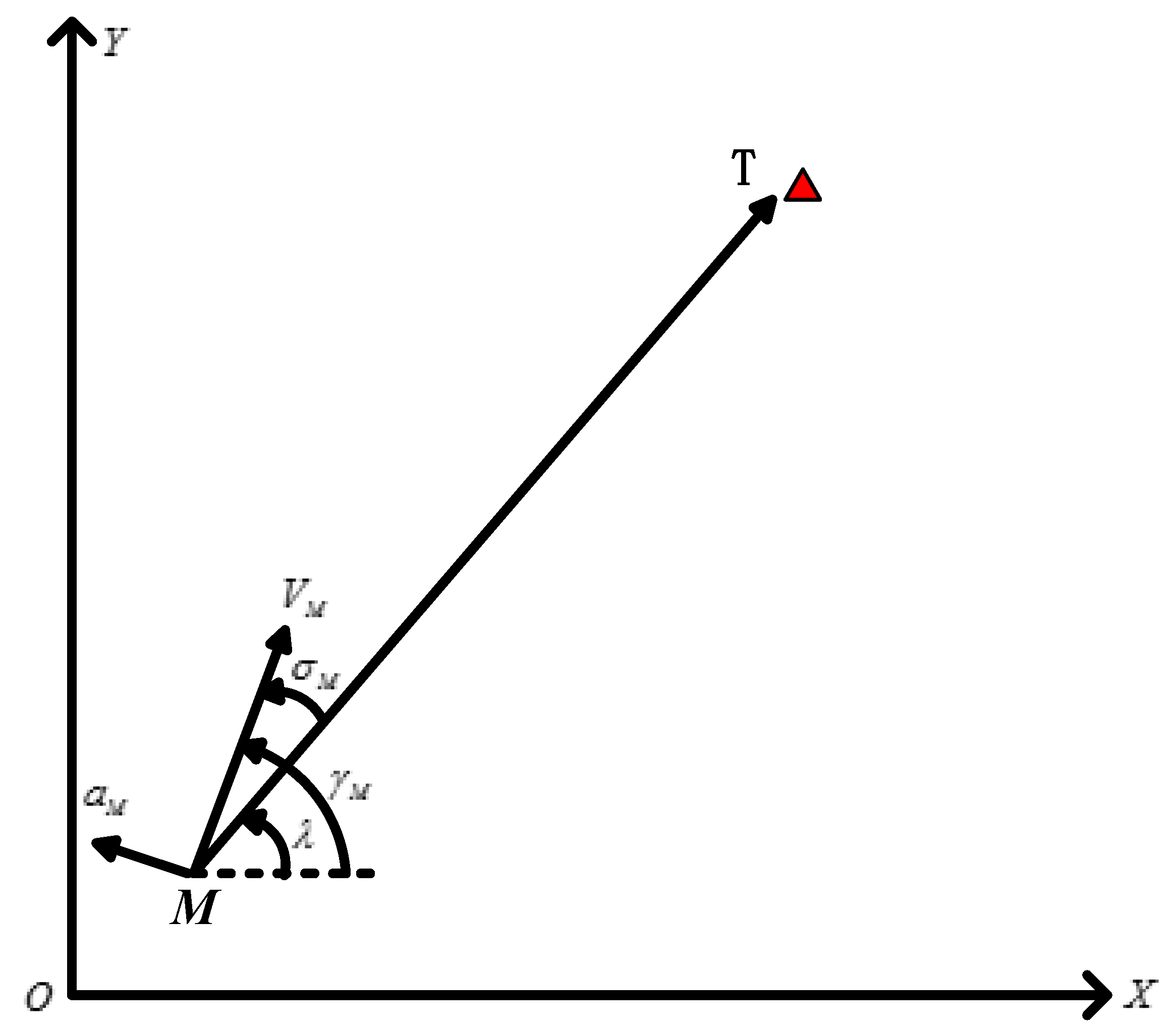
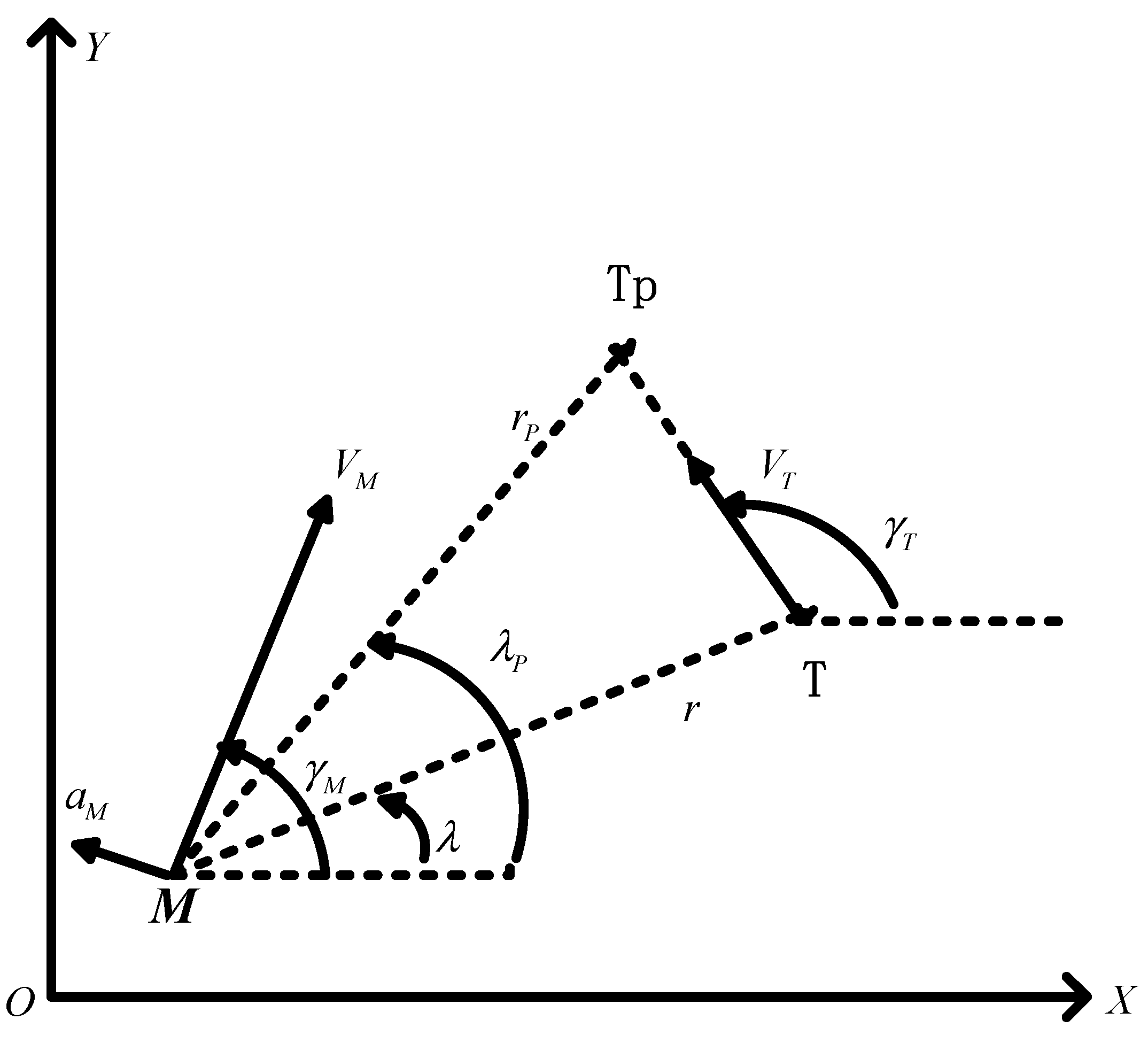
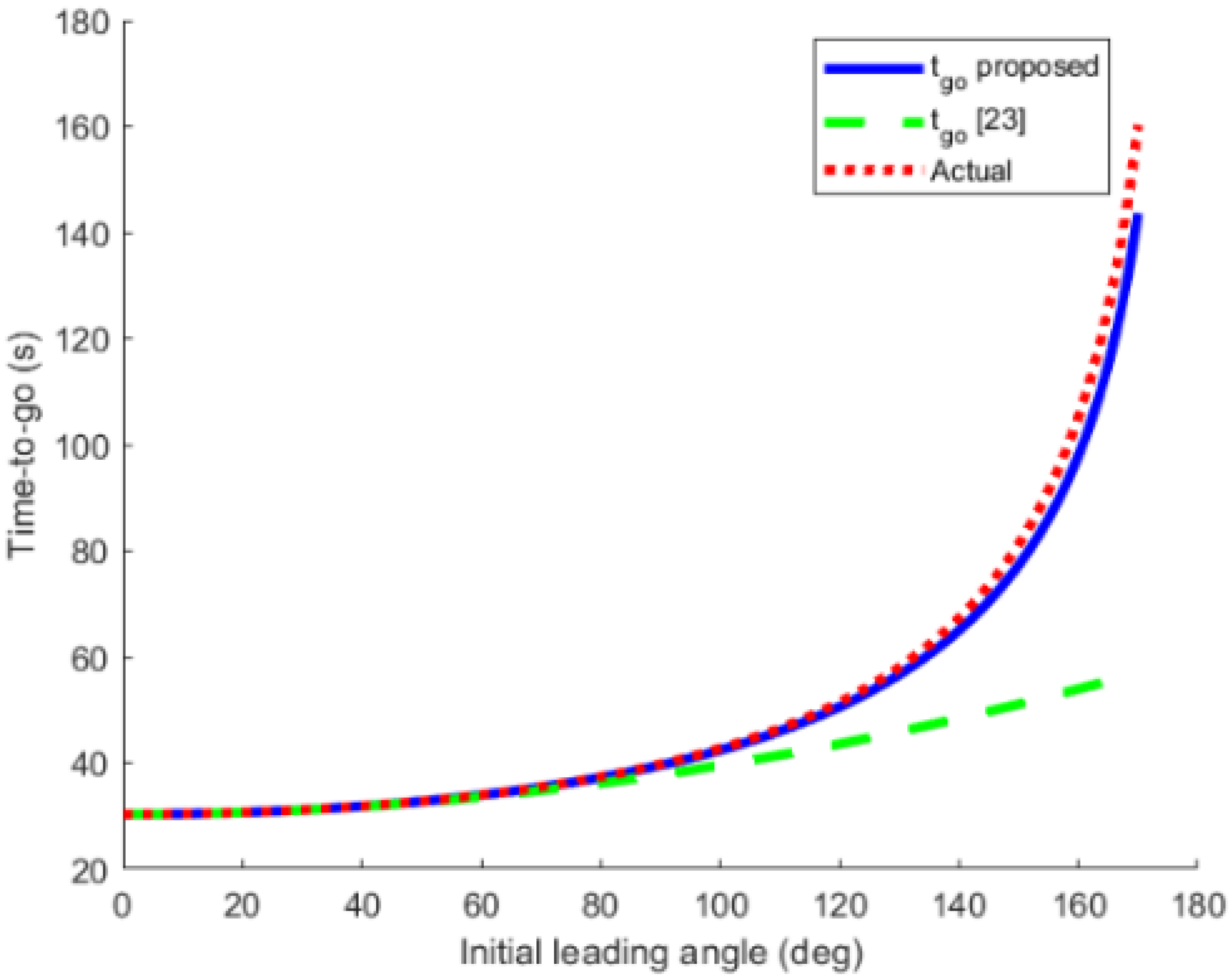
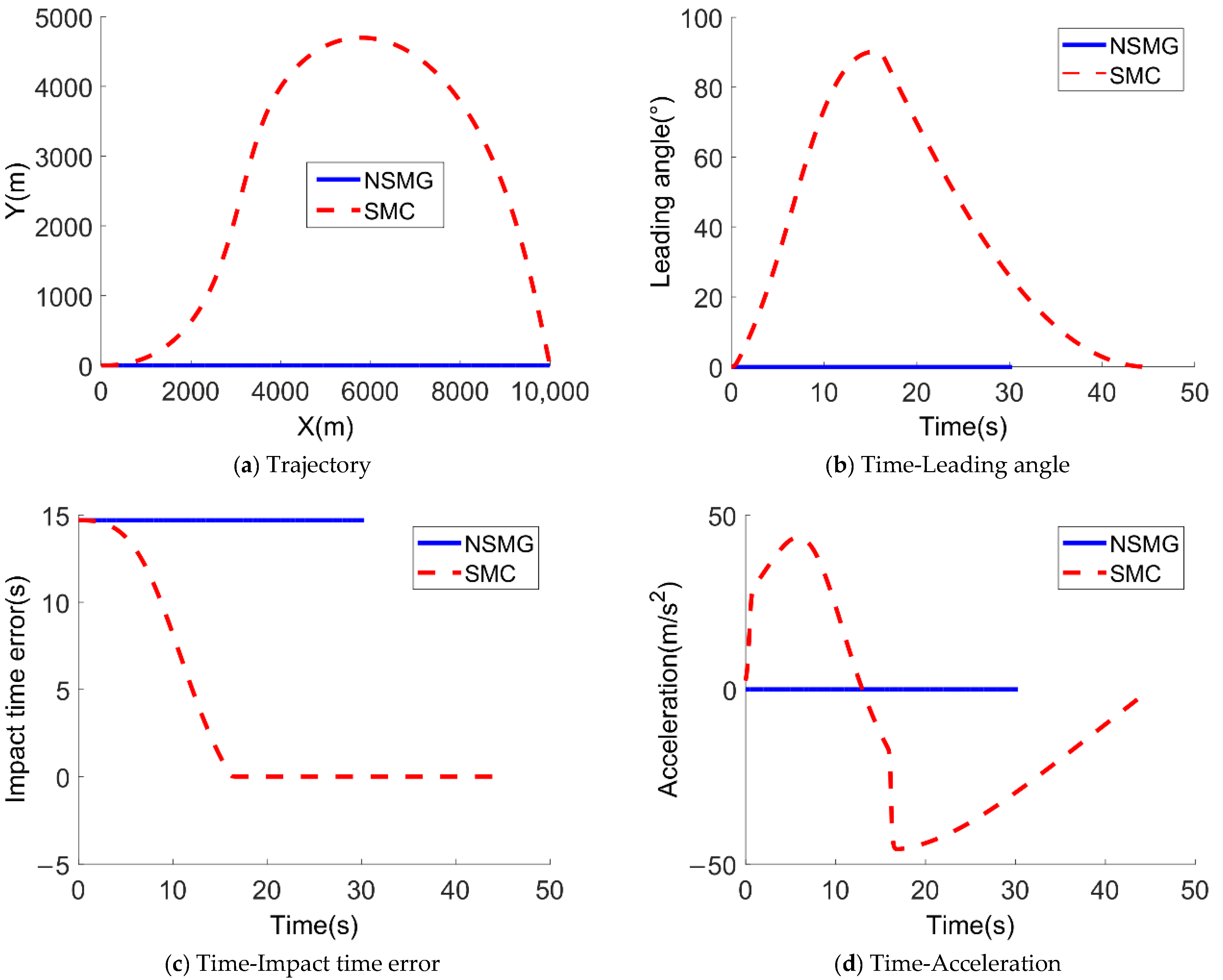


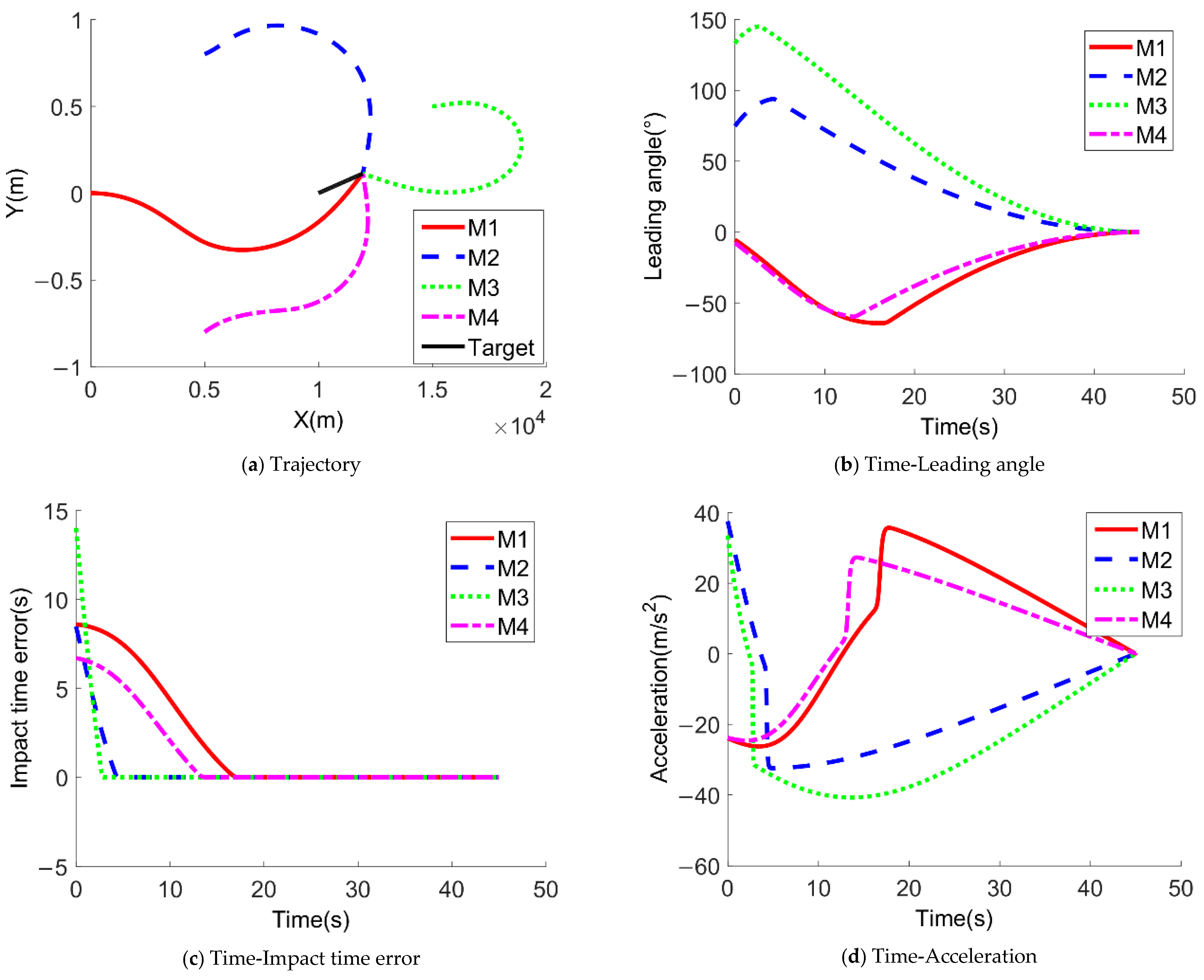

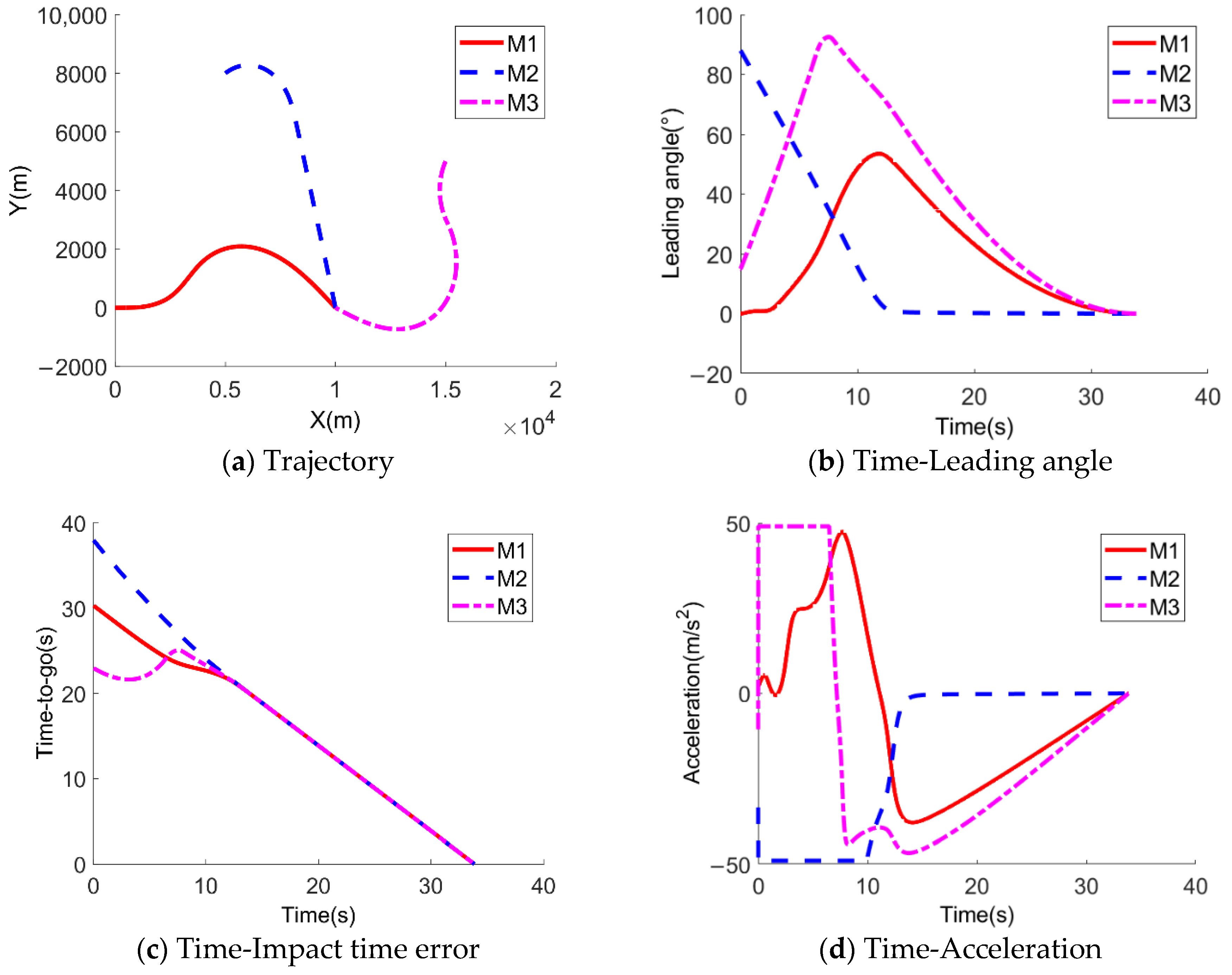
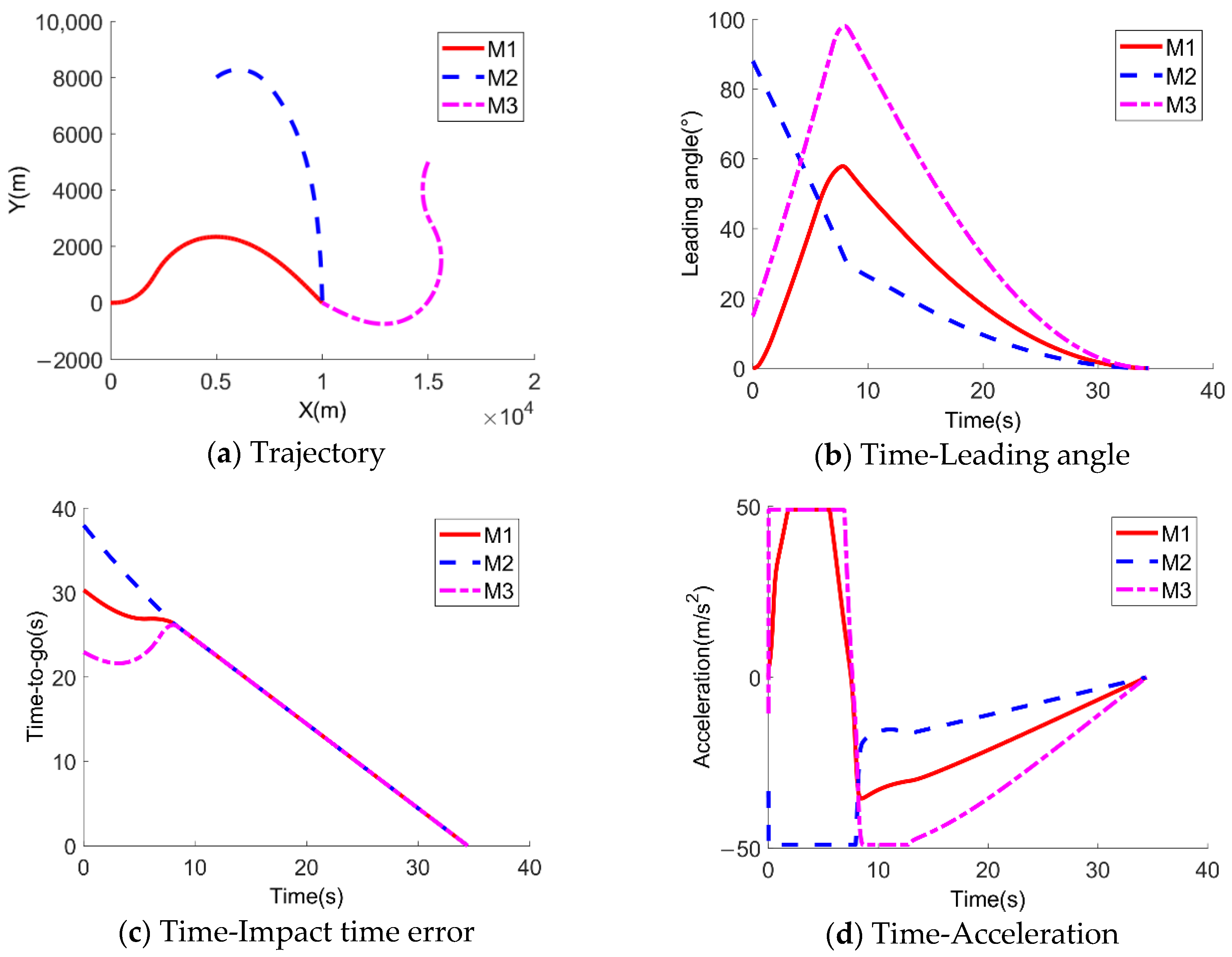
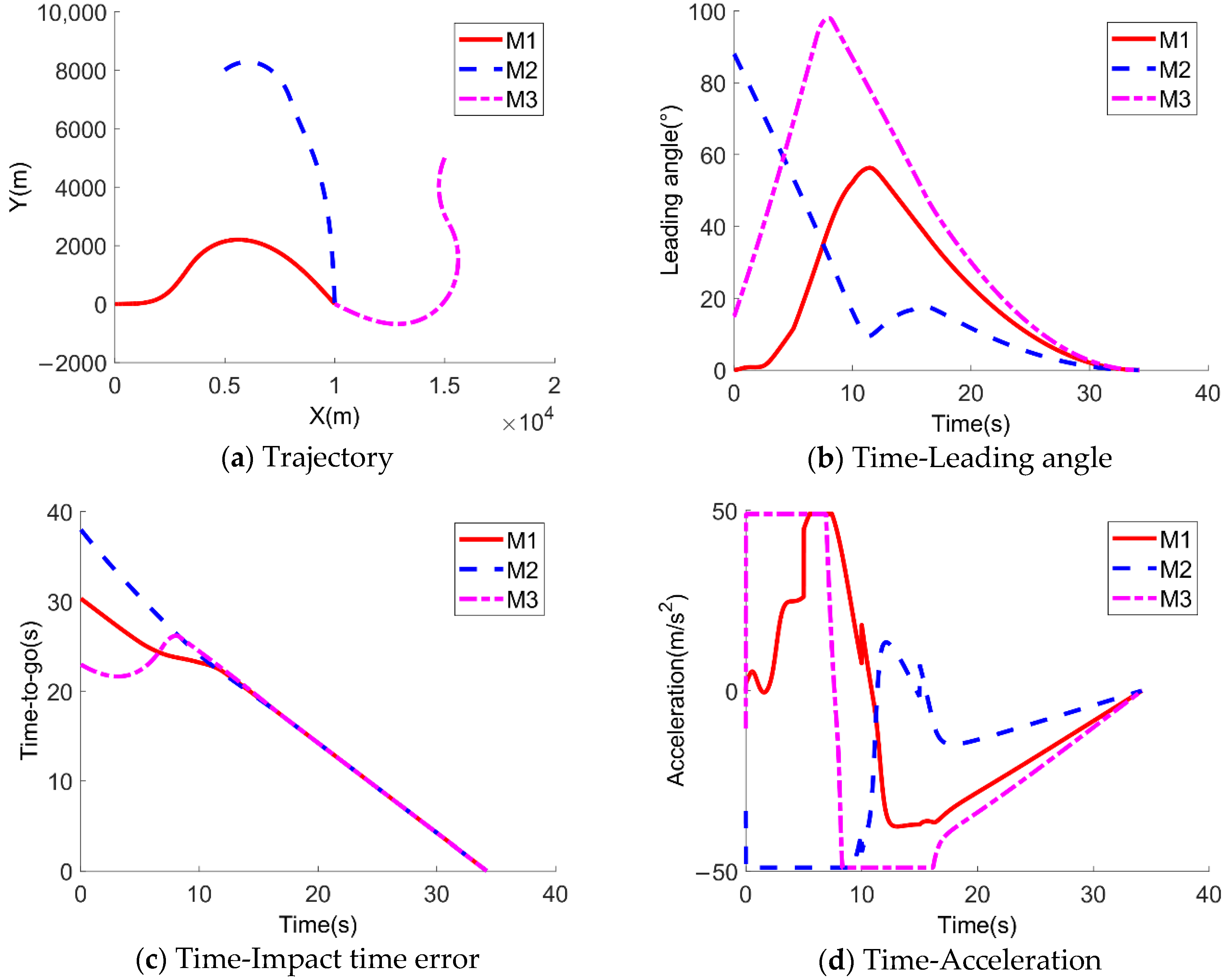
| UAVs/Target | Initial Position (km) | Velocity (m/s) | Initial Flight Path Angle (deg.) | Designated Time (s) |
|---|---|---|---|---|
| M1 | (0,0) | 330 | 0 | 45 |
| M2 | (5,8) | 320 | 30 | |
| M3 | (15,5) | 310 | 5 | |
| M4 | (5,−8) | 300 | 45 | |
| Target | (10,0) | 50 | 30 |
| UAVs | Initial Position (km) | Velocity (m/s) | Initial Flight Path Angle (deg.) | Target Position (km) |
|---|---|---|---|---|
| M1 | (0,0) | 330 | 0 | (10,0) |
| M2 | (5,8) | 320 | 30 | |
| M3 | (15,5) | 310 | −120 |
Publisher’s Note: MDPI stays neutral with regard to jurisdictional claims in published maps and institutional affiliations. |
© 2021 by the authors. Licensee MDPI, Basel, Switzerland. This article is an open access article distributed under the terms and conditions of the Creative Commons Attribution (CC BY) license (https://creativecommons.org/licenses/by/4.0/).
Share and Cite
Jiang, Z.; Ge, J.; Xu, Q.; Yang, T. Terminal Distributed Cooperative Guidance Law for Multiple UAVs Based on Consistency Theory. Appl. Sci. 2021, 11, 8326. https://doi.org/10.3390/app11188326
Jiang Z, Ge J, Xu Q, Yang T. Terminal Distributed Cooperative Guidance Law for Multiple UAVs Based on Consistency Theory. Applied Sciences. 2021; 11(18):8326. https://doi.org/10.3390/app11188326
Chicago/Turabian StyleJiang, Zhanyuan, Jianquan Ge, Qiangqiang Xu, and Tao Yang. 2021. "Terminal Distributed Cooperative Guidance Law for Multiple UAVs Based on Consistency Theory" Applied Sciences 11, no. 18: 8326. https://doi.org/10.3390/app11188326
APA StyleJiang, Z., Ge, J., Xu, Q., & Yang, T. (2021). Terminal Distributed Cooperative Guidance Law for Multiple UAVs Based on Consistency Theory. Applied Sciences, 11(18), 8326. https://doi.org/10.3390/app11188326





